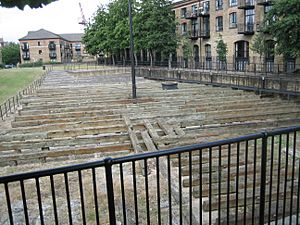Millwall Iron Works facts for kids
The Millwall Iron Works was a huge industrial complex in London, England, that started way back in 1824. It began as several small companies that built ships. As ships got bigger and bigger, these companies joined together to build them.
But in 1866, there was a big financial crisis called the Panic of 1866. This made it very hard to build ships in London, and the main company that owned Millwall Iron Works collapsed. Later, smaller companies tried to bring the works back to life. However, by the end of the 1800s, the area was too small for the giant ships that were being built then.
Most of the old buildings at Millwall Iron Works were located near the tip of the Isle of Dogs peninsula. They survived the Blitz (heavy bombing during World War II) and have since been turned into apartment buildings. This area is now a residential place called Burrells Wharf.
Contents
How It All Began
In the early 1700s, a large piece of land called the Land of Promise estate was located in an area then known as Marshwall (now Millwall). This land was on the north side of the River Thames, east of London. It was owned by a man named Simon Lemon.
Later, a mastmaker (someone who builds ship masts) named Robert Todd bought the estate. He left it to his business partner, Thomas Todd, and his wife's cousin, Elizabeth Ferguson. In 1824, the area started to become more industrial. A company called the Imperial Gas Light & Coke Company built a factory there to process chemicals.
Building Ships with Iron (1835–1846)
In 1835, two Scottish engineers, William Fairbairn and David Napier, bought the Land of Promise estate from Charles Augustus Ferguson. This was a big step in making Millwall an important place for building ships out of iron.
In 1836, Fairbairn set up an ironworks on a three-acre site. Here, they built smaller ships, even though his main factories were in Manchester. Fairbairn built more than 100 ships at Millwall. Most of these ships were under 2,000 tons. They built vessels for the British Navy, and even for the merchant ships of the Tsar of Russia and the King of Denmark.
John Scott Russell Takes Over (1848–1861)
The ironworks didn't make enough money, so in 1848, it was sold to John Scott Russell and his partners. John Scott Russell's company built entire ships at the works. They would completely finish and fit out the ships, then float them onto the river, ready to sail! One of their first big projects was an iron steamship called the Taman. It was finished in 1848 for the Russian government to use in the Black Sea.
The Giant Great Eastern
On January 31, 1858, the biggest ship of its time, the SS Great Eastern, was launched from the 'Napier Yard' at Millwall. This amazing ship was designed by the famous engineer Isambard Kingdom Brunel.
The Great Eastern was 211 meters (692 feet) long. It was so wide that it couldn't be launched straight into the river. Instead, it had to be launched sideways! This made the project much more expensive and caused John Scott Russell's company to go bankrupt.
Because of how difficult it was to launch this ship, it was the last ship of such a huge size to be built on the Isle of Dogs. However, other shipbuilders like Yarrows and Samuda Brothers kept building warships on the island for another 50 years. Today, you can still see a part of the concrete and timber structure from the launch site at Napier Avenue.
A New Company and Big Success (1861–1866)
Charles John Mare took over the iron works. He hired a Welsh industrialist named John Hughes, who became a director of the new company. This company was listed on the London Stock Exchange and was called the Millwall Iron Works, Ship Building & Graving Docks Company Ltd.
The new company improved the works and shipyards, which covered about 27 acres and had a river frontage of 1,900 feet. The Millwall Iron Works became famous for adding iron armor to the Royal Navy's ships. At this time, between 4,000 and 5,000 men worked there.
Working conditions were good for a factory back then. Workers had half-day Saturdays, a canteen, sports clubs, and even a works band! The Millwall Iron Works, along with the Thames Ironworks and Shipbuilding Company, were considered more important to the country than the Royal Navy's own shipyards. They could produce more iron ships and armor than all of France!
The End of an Era (1866)
After the Panic of 1866, a big financial crisis that started when a bank in London failed, the company went out of business. Different parts of the company were bought by other businesses. John Hughes took over the Millwall Iron Works. Another part, the Mast House, was taken over by N. J. & H. Fenner Oil & Lead Works.
Millwall Iron Works Today
By the early 1900s, iron making had stopped at Millwall. The works continued to build and repair smaller ships, and also became a place for making steel parts. Over time, large industrial storage sheds took over the site.
Today, the site has been changed into homes and is called Burrells Wharf. The last new buildings were added there in the early 2000s.


